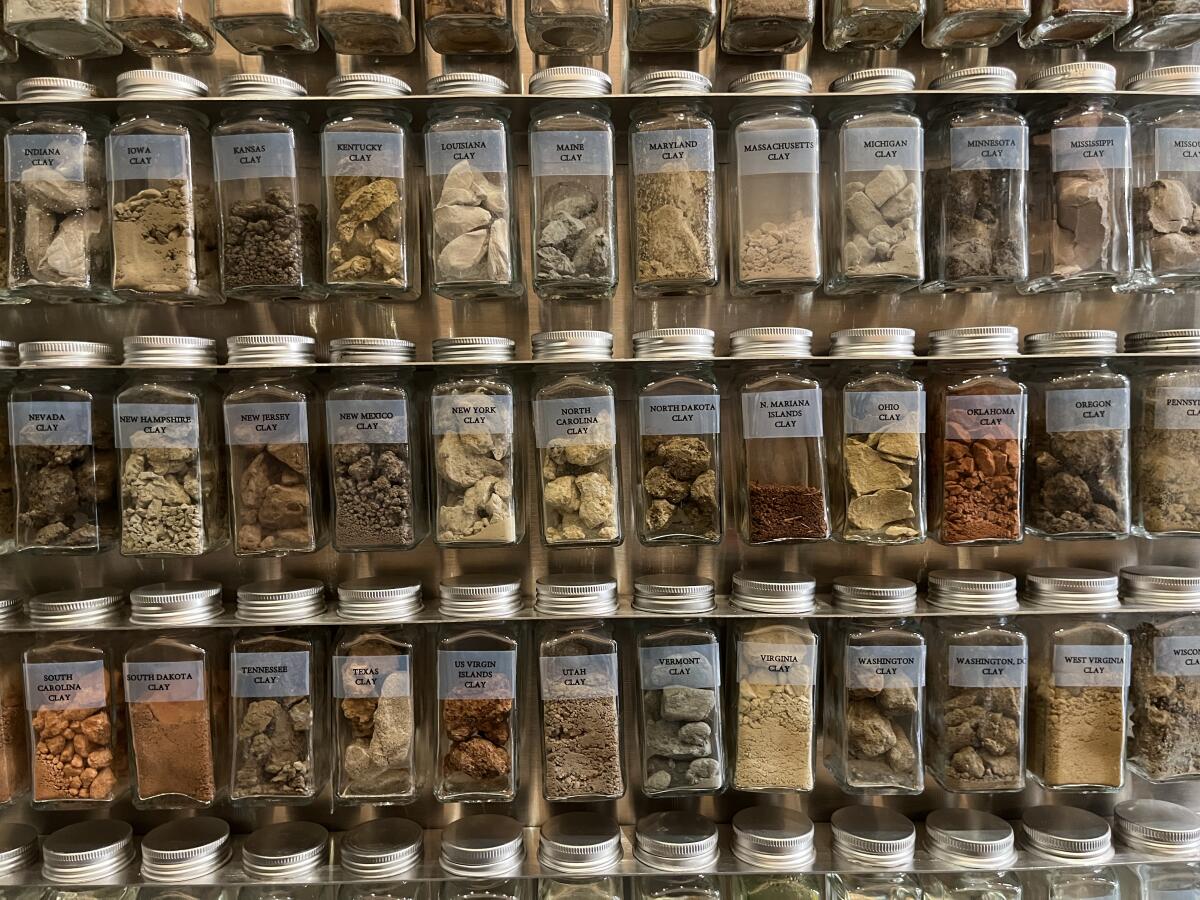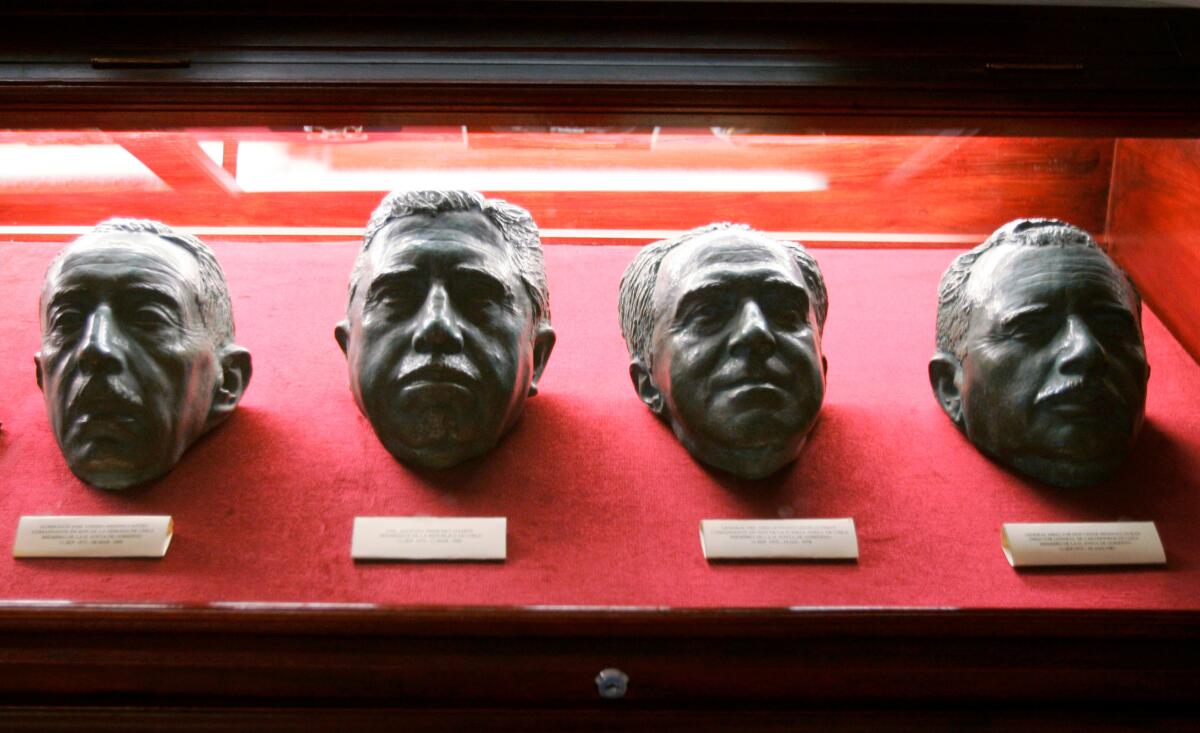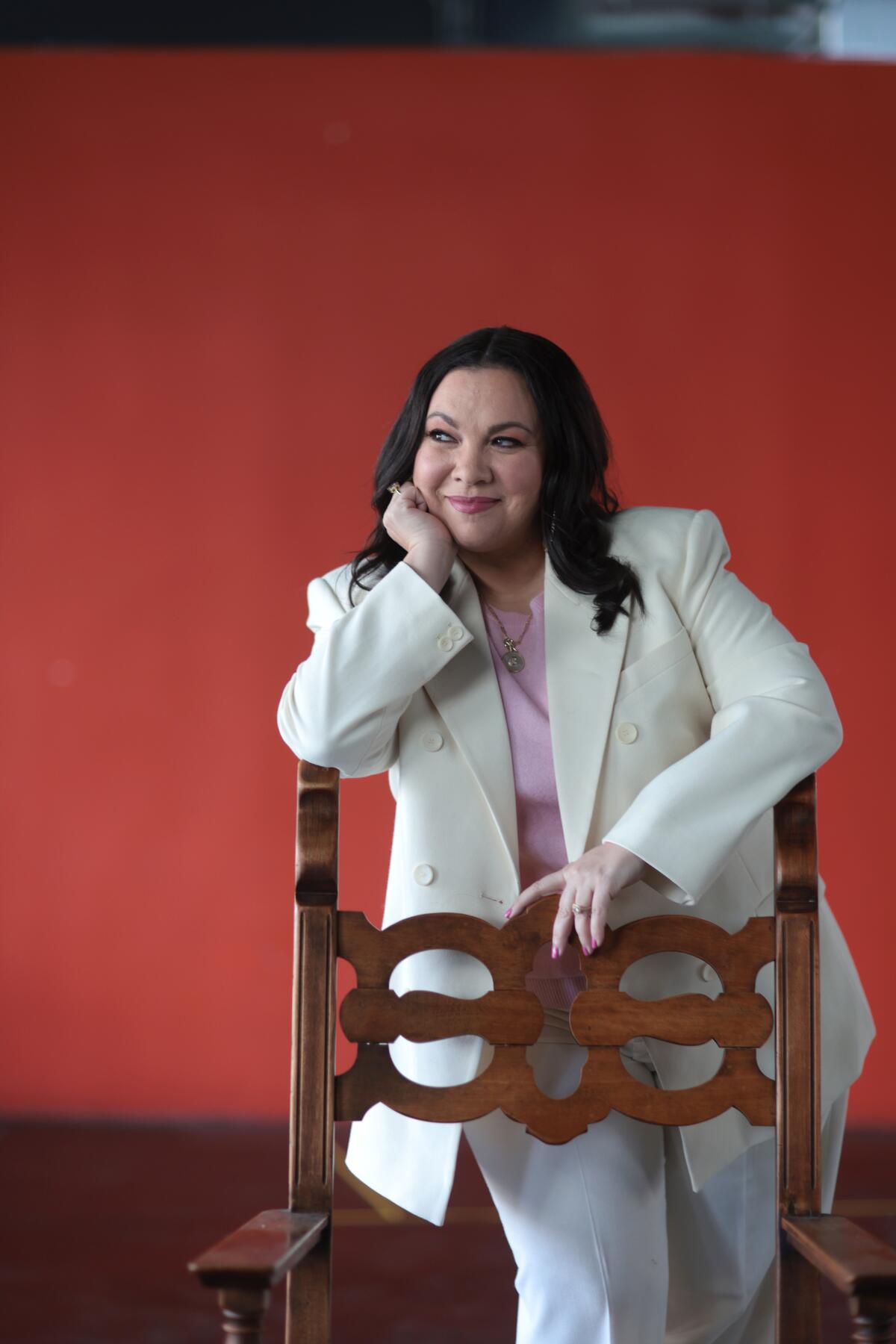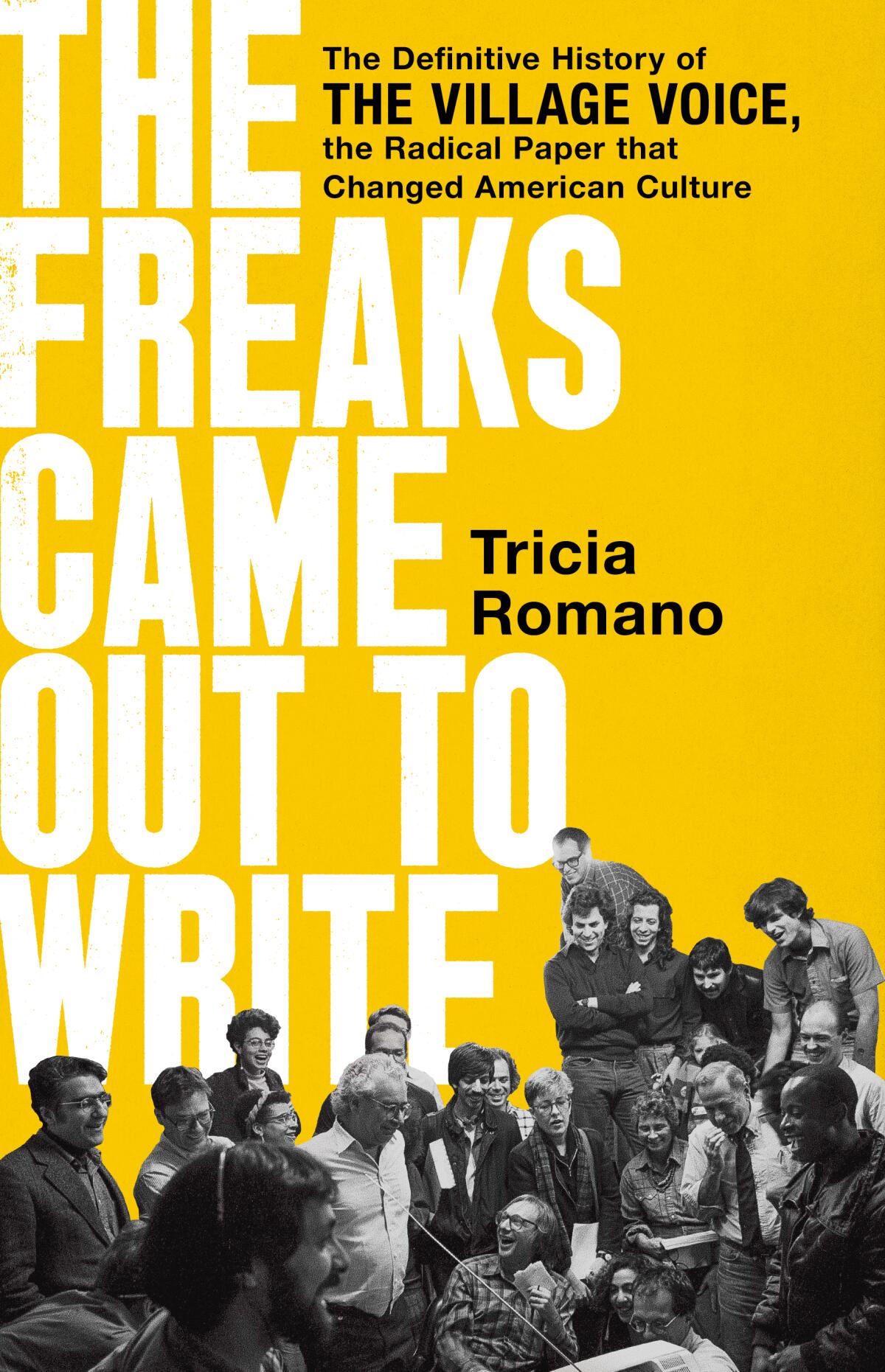A goodbye to The Times and a thank you to readers

It’s the weekend and my main goal is to get over to Café Tropical for a Cuban sandwich. I’m Carolina A. Miranda, art and design columnist for the Los Angeles Times, and this will be my last Essential Arts newsletter:
Thanks for the memories
In late January, I found myself at the Skirball Cultural Center, having dinner on dishware made by artist Adam Silverman — ceramic plates and cups fabricated from clay, water and wood ash from all 50 U.S. states, as well as the five U.S. colonial territories. “Common Ground,” as the piece is titled, consists of 224 earthenware pieces — plates, bowls, cups and ceremonial pots — that are similar to each other in composition but also each unique. The handmade pieces bear quirks of form and shape and distinct striations of the combined clays.
The Skirball recently acquired the work and Silverman is currently an artist-in-residence, hosting gatherings that will put his dishware to use while bringing different strands of Angelenos together. For these events (some public, some private), he has teamed up with Scott Alves Barton, a chef and foodways scholar, whose work has examined the way that identity shapes approaches to food, as well as food in connection to both secular and divine traditions. For our dinner, he helped organize a meal inspired by the food traditions of longtime employees at the Skirball: This included a Belizean/Honduran fish serre (a fish stew cooked in coconut milk) and a small tostada topped with vegetables and a bright slice of hard-boiled egg.
The tostada was the sort of dish, Barton noted, that could be adapted to what was available in the fridge on a given night. He said the point of the dinner was to use the dishware to create community, not present “tweezer food.”

At the dinner, I ran into art writing colleagues Jonathan Griffin, an independent writer I’ve gotten to know through my peregrinations through L.A.’s art world, and Matt Stromberg, who has written for The Times and is a regular contributor to Hyperallergic. Running into my colleagues in the field at events such as this always feels like a mini-reunion, our diffuse little band coming together for ephemeral moments before everyone scurries back to their computers.
My dinner at the Skirball was one of the last I had in my role as a Times journalist, and it will remain poignant. Earlier this month, I accepted a buyout from the company; Friday was my last day.
It’s been a great ride.
You’re reading Essential Arts
Make the most of L.A. with our guide to events and happenings in the SoCal arts scene. In your inbox once a week.
You may occasionally receive promotional content from the Los Angeles Times.
In my years at The Times, I penned a cut-up poem to Jeff Koons, rode a giant egg around North Hollywood, studied the architecture of glory holes in Venice (Italy), examined the excesses of cartel aesthetics, railed against lousy billionaire patronage and ate a handful of gummies before hitting the Vegas Sphere.
Thanks to all the artists, writers, curators, publicists and institutional leaders who collectively welcomed me to their studios, homes, offices and exhibitions, answering my questions, tolerating my incessant follow-up emails and even chewing me out at a fancy museum dinner. Thanks to my editors — Laurie Ochoa, Boris Kachka and Maane Khatchatourian — who regularly saved me from myself. And to art critic Christopher Knight, who graciously answered many penetrating questions like, “What do you call the glow-y thing around a saint?” (Answer: an aureole.)
Ultimately, I take this transition as a welcome opportunity.
I’ve been craving some focused time for a book I intend to write about the time I spent in Chile following the fall of the Pinochet dictatorship, a period of intense cultural transformation. (Also, imagine messy, 19-year-old me in a newly democratic country — it was wild.)

I will remain in L.A. — this is my home — writing about art and whatever else catches my eye. If you’re interested, you can keep up with me via my very personal, highly irregular, not-at-all-dependable personal newsletter, which I have yet to officially launch and which probably won’t properly start up until I’ve stared at a wall for a couple of months. I’ve baptized it “Aesthetic Insecurity.” Because I am muy aesthetic and a bit insecure.
Lastly, thanks to you, Times readers, for giving me your attention. Essential Arts will continue in the hands of my venerable colleagues, who are up on all the essential arts in L.A. So please stay tuned!
Adam Silverman’s “Common Ground” is on view at the Skirball Cultural Center through Jan. 5; skirball.org.
In and out of the galleries
The Museum of Contemporary Art San Diego has put its downtown San Diego buildings on the market — a pair of galleries adjacent to and across from the Santa Fe Depot. “The sale of the downtown facility will dramatically alter perceptions of the museum’s long-standing binational mandate, aimed at artists and audiences in the border area of San Diego and Tijuana,” writes Knight. “Closure also raises difficult questions about the fate of several works of art in the permanent collection. Sculptures and installations by Robert Irwin, Richard Serra, Maya Lin and three other artists were commissioned expressly for the site.”
Meanwhile in L.A.: Knight reviews “Only the Young: Experimental Art in Korea, 1960s-1970s,” currently on view at the Hammer Museum. Organized by New York’s Guggenheim Museum and Korea’s National Museum of Modern and Contemporary Art, it is the first show of its kind in North America. “A common though mistaken assumption is that varieties of Conceptual art erupted in New York and eventually spread out to cover the art globe,” writes Knight of the exhibition. “‘Only the Young’ does an admirable job of presenting the Korean dialect of Conceptual art’s emergent international language.”

Times design writer Lisa Boone profiles glass artist Cedric Mitchell, whose bold, colorful style is informed by graffiti, fashion and Italian design (think: totemic pieces with a Memphis vibe). The scarcity of Black artists in the field has made him determined to take aesthetic risks. “I wanted to break all the design rules similar to Ettore Sottsass,” he tells Boone, “and develop my own style.”
Matt Stromberg reports on the reopening of the expanded Hilbert Museum of California Art at Chapman University. The redesign, led by Johnston Marklee, expanded the museum from 7,500 to 22,000 square feet, and includes a mosaic by Millard Sheets that was relocated from Santa Monica by Brian Worley.
Classical notes
Times classical music critic Mark Swed writes about Esa-Pekka Salonen‘s curtly worded announcement that he would be leaving the San Francisco Symphony — and what that means for other orchestras, including the L.A. Phil. Swed reports that the symphony has an enviable endowment ($315 million) and audiences had picked up after the pandemic, but cutbacks still loomed. “When boards are excellent, they recognize the artistic vision and make miracles happen,” writes Swed. “What has changed over the years is that many boards have become increasingly corporate, increasingly powerful and increasingly clueless.”

Swed was recently in Detroit to catch a performance of John Cage’s “Europeras 3 & 4,” staged by Detroit Opera at the Gem Theatre. The company is led by Yuval Sharon, founder of the Industry, who will soon be back in L.A. with “The Comet/Poppea,” which combines Monteverdi’s 1643 “The Coronation of Poppea” with a newly commissioned opera by George Lewis. “For ‘Europera 4,’ Sharon impressively enticed two stars, mezzo-soprano Susan Graham and bass-baritone Davóne Tines,” writes Swed. “Each has a stunning, polished stage presence and knows it. Cage might have preferred less showiness, but here they felt bigger than life, capable of moving a listener to tears.”
On and off the stage
The Pasadena Playhouse is presenting the world premiere of Gloria Calderón Kellett’s “One of the Good Ones,” a “Guess Who’s Coming to Dinner” story that examines the way a Latine family grapples with identity and race when daughter Yoli (played by Isabella Gomez) invites her new boyfriend to dinner. The dynamics of the play “will be familiar to anyone who’s owned a television set in the last 75 years,” writes Times theater critic Charles McNulty. “What distinguishes Calderón Kellett is the way she reanimates conventional comic material with Latine flavor.”
Plus, The Times’ Ashley Lee interviews Calderón Kellett, who is also a groundbreaking Hollywood showrunner. (She was behind the Rita Moreno-starring reboot of “One Day at a Time” as well as “With Love.”) As she tells Lee of the situation depicted in her play: “Though everyone [onstage] is both right and wrong, and though they might not get any definitive answers by the end of the conversation, that they’re able to talk about it, chip away at it and maybe, over time, they’ll get it — that’s the answer.”

Lee also has the lineup for Tarell Alvin McCraney’s inaugural season at the Geffen Playhouse. Things will get started with a 20th-anniversary staging of McCraney’s “The Brothers Size,” and will include the premiere of Sara Porkalob’s “Dragon Lady” and a reimagining of “Waiting for Godot” starring Conor Lovett and Rainn Wilson — along with much more.
Enjoying this newsletter? Consider subscribing to the Los Angeles Times
Your support helps us deliver the news that matters most. Become a subscriber.
Puppetry is experiencing a surge of interest among a new wave of practitioners in Los Angeles. My colleague Deborah Netburn recently joined a monthly meetup of the L.A. Guild of Puppetry, the largest in the United States.
Book talk
McNulty, who once wrote for and served as an editor at the Village Voice, writes about a new book chronicling the history of the legendary alt-weekly: “The Freaks Came Out to Write” by Tricia Romano. “Romano re-creates through a crisscrossing of interviews the titanic struggles that ensued between the Voice’s largely white, male-dominated news side and the more multicultural roster of arts critics, who were forever migrating from the back pages to the coveted cover,” he writes. “Arts and culture were considered news-making at the Voice, which had the temerity to put on its cover a story I wrote on Lee Breuer’s deconstruction of Ibsen’s ‘A Doll’s House’ with little people.”

Plus, contributor Jessica Ferri has a look at Cynthia Carr’s “Candy Darling: Dreamer, Icon, Superstar.” The iconic Warhol star and early trans icon “lived a life ripe for biography,” writes Ferri. Her research was aided by a cache of interviews recorded in the 1970s by Jeremiah Newton, who had planned to write a biography of Candy but never completed the project.
Essential happenings
Today is the Annual Free-for-All, which means SoCal museums are waiving admission. Can’t make it out on Saturday? The Times’ Sonaiya Kelley rounds up all the free museum days in L.A.
Moves
Kara Felt has been appointed curator of photography at the San Diego Museum of Art.
Phung Huynh, Young Joon Kwak and Na Mira have been named recipients of Artadia’s 2024 Los Angeles awards.
Choreographer Pam Tanowitz will receive the 2024 Jacob’s Pillow Dance Award.
The Avery Fisher Artist Program has announced five 2024 grant recipients. They are the Balourdet Quartet, violinists Njioma Chinyere Grevious and Julian Rhee, pianist Clayton Stephenson and the Sandbox Percussion ensemble.
Passages
Yong Soon Min, an L.A.-based Korean American artist whose work explored identity, has died at the age of 70.
Aribert Reimann, a German opera composer who created radical pieces inspired by literature, is dead at 88.
In the news
— Edward Mendelson has an interesting piece in the New York Review of Books on novelist Zadie Smith‘s first play, “The Wife of Willesden,” inspired by Chaucer’s “The Wife of Bath.”
— Dana Stevens on what makes Judith Butler revolutionary.
— Doug Smith and Angie Orellana Hernandez report on how student housing is transforming the historically Black and Latino neighborhoods around USC.
— The “instant houses” designed by architect Keisuke Kitagawa in the wake of Japan’s Jan. 1 earthquake.
— “The Kitchen Sisters” devote an episode to women architects.
— The new 17-acre Freedom Monument Sculpture Park in Montgomery, Ala., which features work by artists including Alison Saar and Simone Leigh, pays tribute to the lives and stories of the enslaved.
— The grave of Altadena abolitionist Owen Brown has been designated a county historic landmark.
— Winston Churchill (yes, that Winston Churchill) has a show in Palm Springs.
— Is AI one big hype bubble? Edward Zitron digs in.
— Thanks to the “Unladylike” podcast for having me on to talk about cool aunties, which I wrote about last month.
And last but not least ...
The biggest entertainment stories
Get our big stories about Hollywood, film, television, music, arts, culture and more right in your inbox as soon as they publish.
You may occasionally receive promotional content from the Los Angeles Times.



